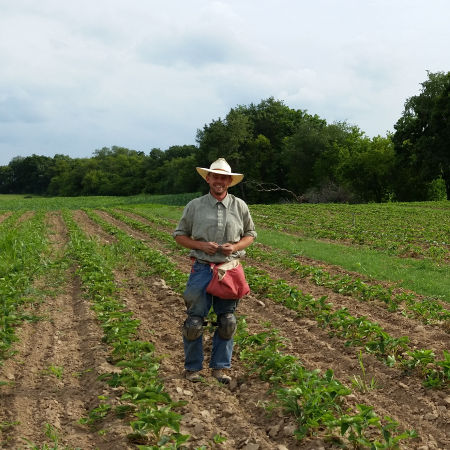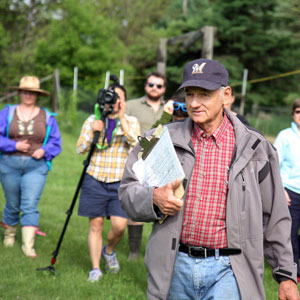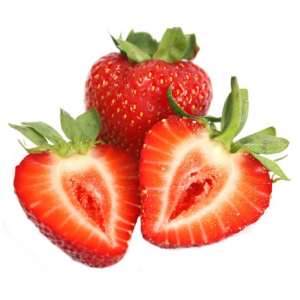
Growing & Management Practices
Evolution of Integrated Pest Management
From the time that the human race shifted emphasis from a hunter/gatherer society to an agricultural society, land stewardship has been the key to survival. A healthy society depends on a healthy soil, which in turn depends on diversity that recycles wastes, maintains ecological balance and replenishes fertility. Throughout history, societies have risen and fallen bases on their relationship with the soil. These relationships are especially noticeable in fragile ecosystems where rainfall, temperature and organic matter limit ecological resilience, but there is no ecosystem on earth that cannot be depleted and eventually destroyed.
Fast forward to the 1940’s and 1950’s. The industrial revolution was going to completely revolutionize agriculture. Of course, tractors and farm machinery had already replaced the need for much hand labor, but now we could even ignore the natural ecological processes by substituting chemically produced pesticides and fertilizers. Fueled by corporate interests and the concern for feeding an increasing world population, society rushed into the unknown world of chemical agriculture with little understanding of the potential consequences.
In less than a decade the ecological damage from the indiscriminate use of this new technology was becoming alarmingly apparent. Rachel Carson’s Silent Spring, helped galvanize a counter-movement. Organic gardening was the reactive response to the concern that these new compounds might be reducing the long-term productivity of our soils. To avoid evolving and still unknown risks, the organic movement prohibited all man-made compounds and allowed only natural fertilizers and pesticides to be used (over time this distinction has been somewhat blurred, but is still the philosophical basis for approving new substances for use in organic farming systems.)
Fast-forward again to the 1990’s. Thirty years of research became the basis for an alternative management system that is ecologically based, but recognizes technology can be a part of an intensive management system. This system is called Integrated Pest Management (IPM). IPM is based on the organic farming principle of maintaining soil fertility for future generations, and recognizes that well researched technological tools can be incorporated to enhance sustainability.
Summary of Management Tools
Our management philosophy is to work with and enhance natural ecological systems. Intervention is used as last resort and only to the extent that it is predictable and necessary.
From the time that the human race shifted emphasis from a hunter/gatherer society to an agricultural society, land stewardship has been the key to survival. A healthy society depends on a healthy soil, which in turn depends on diversity that recycles wastes, maintains ecological balance and replenishes fertility. Throughout history, societies have risen and fallen bases on their relationship with the soil. These relationships are especially noticeable in fragile ecosystems where rainfall, temperature and organic matter limit ecological resilience, but there is no ecosystem on earth that cannot be depleted and eventually destroyed.
Fast forward to the 1940’s and 1950’s. The industrial revolution was going to completely revolutionize agriculture. Of course, tractors and farm machinery had already replaced the need for much hand labor, but now we could even ignore the natural ecological processes by substituting chemically produced pesticides and fertilizers. Fueled by corporate interests and the concern for feeding an increasing world population, society rushed into the unknown world of chemical agriculture with little understanding of the potential consequences.
In less than a decade the ecological damage from the indiscriminate use of this new technology was becoming alarmingly apparent. Rachel Carson’s Silent Spring, helped galvanize a counter-movement. Organic gardening was the reactive response to the concern that these new compounds might be reducing the long-term productivity of our soils. To avoid evolving and still unknown risks, the organic movement prohibited all man-made compounds and allowed only natural fertilizers and pesticides to be used (over time this distinction has been somewhat blurred, but is still the philosophical basis for approving new substances for use in organic farming systems.)
Fast-forward again to the 1990’s. Thirty years of research became the basis for an alternative management system that is ecologically based, but recognizes technology can be a part of an intensive management system. This system is called Integrated Pest Management (IPM). IPM is based on the organic farming principle of maintaining soil fertility for future generations, and recognizes that well researched technological tools can be incorporated to enhance sustainability.
Summary of Management Tools
Our management philosophy is to work with and enhance natural ecological systems. Intervention is used as last resort and only to the extent that it is predictable and necessary.
Cultural tools and management practices include:
~ crop rotation
~ wind breaks
~ plant density
~ row orientation to maximize sunlight, air and water drainage,
~ green manure crops
~ cover crops
~ removal of diseased foliage and plants
~ mechanical cultivation
~ hand weeding
~ planting resistant varieties
~ preserving natural predators
~ monitoring weather conditions favorable for disease,
~ field scouting to identify pest problems
~ using pest damage threshold levels to see if pesticide intervention is needed to prevent crop failure or to maintain quality
If pesticides are incorporated into the system, they are selected on the basis of least toxicity and timed or applied in a manner that eliminates or minimizes contact with fruit.
~ crop rotation
~ wind breaks
~ plant density
~ row orientation to maximize sunlight, air and water drainage,
~ green manure crops
~ cover crops
~ removal of diseased foliage and plants
~ mechanical cultivation
~ hand weeding
~ planting resistant varieties
~ preserving natural predators
~ monitoring weather conditions favorable for disease,
~ field scouting to identify pest problems
~ using pest damage threshold levels to see if pesticide intervention is needed to prevent crop failure or to maintain quality
If pesticides are incorporated into the system, they are selected on the basis of least toxicity and timed or applied in a manner that eliminates or minimizes contact with fruit.
IPM Tool Chest
Agriculture is always the most sustainable when the widest possible range of production tools can be used (click on Issues Concerning Us All for information about sustainability.) Over the years we have learned how to incorporate individual management tools into a comprehensive management system that requires the understanding and regard for interactions among the various components. This is an adaptive system that is responsive to changing circumstances. The result is an Integrated Production Management (IPM) system that we feel is even more comprehensive than the Integrated Pest Management practices generally associated with this acronym.
Cultural Considerations
Cultural management practices are the most basic and important tools in our IPM tool chest. We are ever mindful that sustainable agricultural systems must complement, rather than exploit, natural ecological systems.
A. Varietal resistance to pests
B. Site selection and field layout
a. Use prevailing wind direction for fast foliage dry down
b. Use natural topographic features for good surface drainage
c. Use slope and sun exposure to maximize crop response
d. Use existing (or establish) windbreaks to reduce soil loss and wind stress
e. Avoid excessive slope to reduce soil erosion and nutrient loss
f. Avoid soils with poor nutrient attenuation (sandy, shallow, high ground water)
C. Management practices
a. Use shallow cultivation for weed control
b. Time overhead irrigation to avoid long periods of leaf wetness
c. Use organic mulch to:
1. Reduce raindrop impact on bare soil
2. Reduce spread of soil borne foliar and fruit diseases
3. Reduce soil temperature
4. Conserve moisture
5. Retard weed germination
6. Provide winter protection
d. Add compost as a soil conditioner
e. Add soil nutrients based on soil nutrient testing
f. Use of leaf nutrient analysis
g. Formulate a strategy to avoid soil compaction
1. Minimize trips through field
2. Use lightest equipment with widest tires
3. Avoid entry during wet periods
4. Use mechanical sub-soiler
h. Incorporate green manure crops
i. Rogue diseased plants
j. Prune and destroy diseased tissue (trees)
k. Mow surrounding areas to reduce source of weed seeds
l. Practice crop rotation
1. Rotate with dissimilar crops to break the pathogen cycle
2. Rotate with legumes to fix nitrogen and increase fertility
3. Rotate with cover crops that have allelopathic properties
B. Site selection and field layout
a. Use prevailing wind direction for fast foliage dry down
b. Use natural topographic features for good surface drainage
c. Use slope and sun exposure to maximize crop response
d. Use existing (or establish) windbreaks to reduce soil loss and wind stress
e. Avoid excessive slope to reduce soil erosion and nutrient loss
f. Avoid soils with poor nutrient attenuation (sandy, shallow, high ground water)
C. Management practices
a. Use shallow cultivation for weed control
b. Time overhead irrigation to avoid long periods of leaf wetness
c. Use organic mulch to:
1. Reduce raindrop impact on bare soil
2. Reduce spread of soil borne foliar and fruit diseases
3. Reduce soil temperature
4. Conserve moisture
5. Retard weed germination
6. Provide winter protection
d. Add compost as a soil conditioner
e. Add soil nutrients based on soil nutrient testing
f. Use of leaf nutrient analysis
g. Formulate a strategy to avoid soil compaction
1. Minimize trips through field
2. Use lightest equipment with widest tires
3. Avoid entry during wet periods
4. Use mechanical sub-soiler
h. Incorporate green manure crops
i. Rogue diseased plants
j. Prune and destroy diseased tissue (trees)
k. Mow surrounding areas to reduce source of weed seeds
l. Practice crop rotation
1. Rotate with dissimilar crops to break the pathogen cycle
2. Rotate with legumes to fix nitrogen and increase fertility
3. Rotate with cover crops that have allelopathic properties
Natural Biological Control Considerations
Natural biological control organisms (NCOs) range from soil bacteria to mammals. Control methods include competition, parasitism, allelopathic effects, toxic releases, micro-environmental modification and predatiousness.
A. Identify pest organisms
B. Identify Natural Control Organisms (NCO)
B. Identify Natural Control Organisms (NCO)
C. Identify the environmental needs of NCOs
a. Habitat requirements
b. Food sources
c. Life cycles
d. Vulnerability to inorganic compounds (pesticide groups)
D. Environmental enhancement
a. Provide cover
b. Modify mechanical practices that damage habitat
c. Provide (alternate) food sources
d. Adjust cultural practices
e. Coordinate other practices with NCO life cycle
f. Avoid and/or time pesticide intervention to protect NCO’s
g. Provide alternative habitat (e.g. nesting sites for birds)
Threshold Considerations
Checking our fields on a continuous basis for pest problems is a critical part of IPM. It is important to identify problems early. Damage threshold is when actual damage starts to show up. Action threshold is when damage becomes sever enough that pesticide intervention would be considered to maintain crop yield and/or quality. In our management system, the plants’ natural immune response and NCO’s, usually keep pest damage below the action threshold.
A. Monitor pest types and numbers
B. Monitor pest distribution
C. Monitor conditions favorable for pest outbreak
D. Monitor the presence of control organisms
E. Use established action threshold for intervention (depending on status of NCOs)
F. Use experience and judgment
G. Use chemical intervention only when the action threshold has been reached (for insects and weeds)
H. Intervene for fungal diseases based on point C (above)
B. Monitor pest distribution
C. Monitor conditions favorable for pest outbreak
D. Monitor the presence of control organisms
E. Use established action threshold for intervention (depending on status of NCOs)
F. Use experience and judgment
G. Use chemical intervention only when the action threshold has been reached (for insects and weeds)
H. Intervene for fungal diseases based on point C (above)
Biological Intervention
A. Consider importing biological agents native to the area to enhance NCO’s
B. Avoid introducing new exotic control organisms that:
a. Probably not survive long enough to be effective
b. Could have an unanticipated negative affect on the environment
Chemical Pesticide Intervention
A. Used as the last line of defense against pests
B. Used only when economic threshold levels have been reached or are imminent (in case of fungal diseases)
C. Material selection based on:
a. Least impact on natural NCO’s and pollinators
b. Least residue concerns
c. Least persistence in the environment
c. Least persistence in the environment
d. Least potential for leaching and ground water contamination
e. The most targeted to the pest
f. Efficacy to control the target pest
g. Least toxic to handle
h. Availability and cost effectiveness
D. To be applied as a spot treatment if possible
E. To be applied at the lowest effective rate
F. Timed to avoid contact with fruit
G. Discontinued well in advance of harvest
Summary
Healthy plants can tolerate some degree of insect and disease pressure before fruit quality and yield are affected. In fact, a certain amount of stress is required to activate a plants’ natural immune response. Recent research suggests that some level of disease and insect pressure is necessary for fruits and vegetables to produce optimum levels of phenolic metabolites that platy critical roles in human health due to their potent antioxidant activity and anti-cancer properties.
A recent article in the Journal of Agriculture and Food Chemistry (VOL. 51, No. 5, 2003), found that these important nutraceutical compounds were “highest in crops grown by sustainable (IPM) agricultural methods”. This may reflect a needed balance between plant nutrition and the requisite pathogenic pressures that lead to the optimum synthesis of TP’s (total phenolics).
 Farm Research
Farm ResearchTo learn more about the uncommon, unusual and overlooked fruit trials at Carandale Farm, click here.



